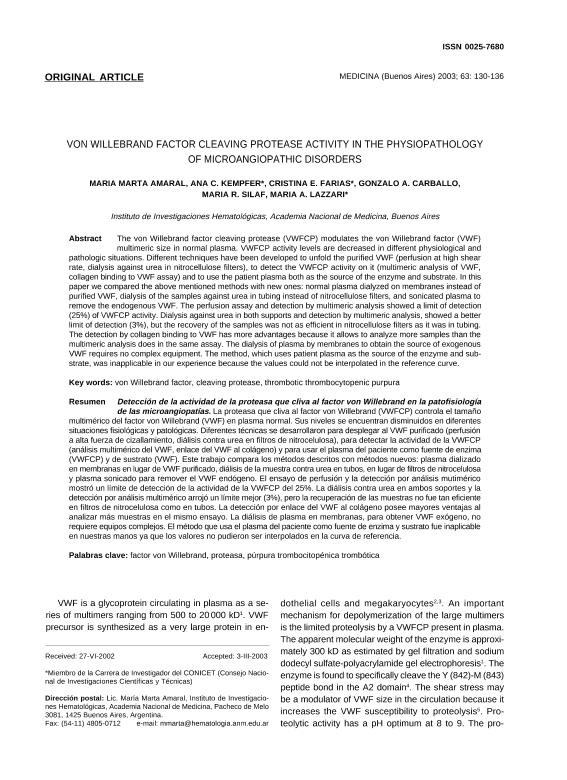Artículo
La proteasa que cliva al factor von Willebrand (VWFCP) controla el tamaño multimérico del factor von Willebrand (VWF) en plasma normal. Sus niveles se encuentran disminuidos en diferentes situaciones fisiológicas y patológicas. Diferentes técnicas se desarrollaron para desplegar al VWF purificado (perfusión a alta fuerza de cizallamiento, diálisis contra urea en filtros de nitrocelulosa), para detectar la actividad de la VWFCP (análisis multimérico del VWF, enlace del VWF al colágeno) y para usar el plasma del paciente como fuente de enzima (VWFCP) y de sustrato (VWF). Este trabajo compara los métodos descritos con métodos nuevos: plasma dializado en membranas en lugar de VWF purificado, diálisis de la muestra contra urea en tubos, en lugar de filtros de nitrocelulosa y plasma sonicado para remover el VWF endógeno. El ensayo de perfusión y la detección por análisis mutimérico mostró un límite de detección de la actividad de la VWFCP del 25%. La diálisis contra urea en ambos soportes y la detección por análisis multimérico arrojó un límite mejor (3%), pero la recuperación de las muestras no fue tan eficiente en filtros de nitrocelulosa como en tubos. La detección por enlace del VWF al colágeno posee mayores ventajas al analizar más muestras en el mismo ensayo. La diálisis de plasma en membranas, para obtener VWF exógeno, no requiere equipos complejos. El método que usa el plasma del paciente como fuente de enzima y sustrato fue inaplicable en nuestras manos ya que los valores no pudieron ser interpolados en la curva de referencia. The von Willebrand factor cleaving protease (VWFCP) modulates the von Willebrand factor (VWF) multimeric size in normal plasma. VWFCP activity levels are decreased in different physiological and pathologic situations. Different techniques have been developed to unfold the purified VWF (perfusion at high shear rate, dialysis against urea in nitrocellulose filters), to detect the VWFCP activity on it (multimeric analysis of VWF, collagen binding to VWF assay) and to use the patient plasma both as the source of the enzyme and substrate. In this paper we compared the above mentioned methods with new ones: normal plasma dialyzed on membranes instead of purified VWF, dialysis of the samples against urea in tubing instead of nitrocellulose filters, and sonicated plasma to remove the endogenous VWF. The perfusion assay and detection by multimeric analysis showed a limit of detection (25%) of VWFCP activity. Dialysis against urea in both supports and detection by multimeric analysis, showed a better limit of detection (3%), but the recovery of the samples was not as efficient in nitrocellulose filters as it was in tubing. The detection by collagen binding to VWF has more advantages because it allows to analyze more samples than the multimeric analysis does in the same assay. The dialysis of plasma by membranes to obtain the source of exogenous VWF requires no complex equipment. The method, which uses patient plasma as the source of the enzyme and substrate, was inapplicable in our experience because the values could not be interpolated in the reference curve.
Von Willebrand factor cleaving protease activity in the pathophysiology of microangiopathic disorders
Título:
Detección de la actividad de la proteasa que cliva al factor von Willebrand en la patofisiología de las microangiopatías
Amaral, María Marta ; Kempfer, Ana Catalina
; Kempfer, Ana Catalina ; Farias, Cristina Elena
; Farias, Cristina Elena ; Carballo, Gonzalo A.; Silaf, María R.; Lazzari, María Ángela
; Carballo, Gonzalo A.; Silaf, María R.; Lazzari, María Ángela
 ; Kempfer, Ana Catalina
; Kempfer, Ana Catalina ; Farias, Cristina Elena
; Farias, Cristina Elena ; Carballo, Gonzalo A.; Silaf, María R.; Lazzari, María Ángela
; Carballo, Gonzalo A.; Silaf, María R.; Lazzari, María Ángela
Fecha de publicación:
02/2003
Editorial:
Revista Medicina
Revista:
Medicina (Buenos Aires)
ISSN:
0025-7680
e-ISSN:
1669-9106
Idioma:
Inglés
Tipo de recurso:
Artículo publicado
Clasificación temática:
Resumen
Archivos asociados
Licencia
Identificadores
Colecciones
Articulos(IMEX)
Articulos de INST.DE MEDICINA EXPERIMENTAL
Articulos de INST.DE MEDICINA EXPERIMENTAL
Citación
Amaral, María Marta; Kempfer, Ana Catalina; Farias, Cristina Elena; Carballo, Gonzalo A.; Silaf, María R.; et al.; Von Willebrand factor cleaving protease activity in the pathophysiology of microangiopathic disorders; Revista Medicina; Medicina (Buenos Aires); 63; 2-2003; 130-136
Compartir



